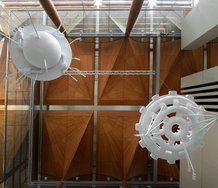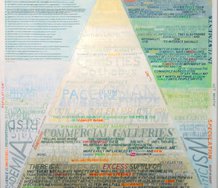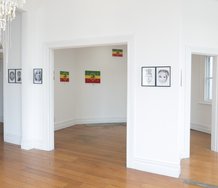Ralph Paine – 4 April, 2016
We gather that relations between the everyday aesthetic flow and the division of aesthetic labour remain over-coded - and thus at times blocked - by the old and now partially hidden categories of, and separation between, art and craft. Here's a bunch of concerns we possess in common, both as members of the various specialist groups and as participants in the aesthetic rhythms of the quotidian.
.
How many drips, with water so clear? How many years? Since the old time, the time when all the animals were people, and they walked in a dream together. Since the world was born out of its first egg.
- Kim Stanley Robinson, Shaman
… You decide to recover an old sofa with that chintz fabric your grandmother gave you years ago … You plant a climbing rose to grow luxuriantly through the big old plum tree that’s slowly dying in the backyard … This afternoon your friend is calling round with the tattoo design she’s been promising you for months … Next door a new house is going up and for brief moments each day you contemplate some intricacy of its construction … Leaving the hotel before dawn you walk to a nearby park on a point overlooking the ocean - little by little, orange, pink, cerulean sky . . .
All of us travel this aesthetic flow. Transfixed, we gather time in its speeds and slownesses. Aesthetic flow is there in everyday experience. We sew, cook, and garden. We pin things up on our bedroom walls, send flowers with cards of sorrow attached, dress up for the night and go out dancing … Other times we stay home and whisper ghost stories to children at bedtime. Such is perception and sensation, the power to affect/be affected. Decoration, display, ritual, beauty, tragedy, eeriness, sublimity, comedy, fabulation … All names of differing aesthetic vibe, myriad shape-shifting contrasts of abstract potentiality, yet all simultaneously melded into the surrounding animal-mineral-vegetable zones, the rhythms of the chaosmos itself. In other words, we dwell aesthetically.
Meanwhile, these same powers and concerns take up the measured time of labour, the time of workers: artists, artisans, technicians, specialists. Each group or network of these aesthetic specialists possesses certain formal skills and technical procedures, including the skill of reproducing themselves as a group, the later frequently involving complex de-skilling/re-skilling procedures. Each group shares a unique genealogy in the form of resonating sets of inherited problems and their existing solutions, and always the group is in the process of forming new problems and projected solutions. All groups have intimate, nuanced connections both across the full range of the other specialist activities and throughout the flow of the everyday aesthetic world.
Let’s extract a problematic from these rather sketchy ideas. On the one hand there is the real of an everyday aesthetic flow in which we all partake; and on the other, this flow - fabric of flows - is overlaid by a work-based division of labour. Yet we sense the vestiges of another division operating here. We gather that relations between the everyday aesthetic flow and the division of aesthetic labour remain over-coded - and thus at times blocked - by the old and now partially hidden categories of, and separation between, art and craft. Here’s a bunch of concerns we possess in common, both as members of the various specialist groups and as participants in the aesthetic rhythms of the quotidian. How is it that our lives became over-coded in this way?
Etymology is always a useful tool. It’s that branch of linguistics investigating the historical formation of words, of how words have changed over time and why they have changed. Let’s start with “aesthetic.” In its modern sense the word had a very precise time and place of birth.
In Berlin 1750 the German philosopher Alexander Baumgarten published a tract titled Aesthetica, and in doing so baptised a new concept: German = Ästhetik, French = esthétique. As is the remarkable habit of German philosophers, Baumgarten was familiar with the force of etymology: he took interpretive freedom in naming his new concept. The word’s prehistory lies in Ancient Greece with the word aisthêtikos, meaning “of the senses, of perception.” Using the terms “appearances,” “sense data,” “phenomena,” “cognition,” etc. philosophers (and scientists) are always already conjuring up new theories of perception and sensation. These theories posit solutions to the mind-body problem, sometimes named the subject-substance problem. But after Baumgarten many philosophical theories of perception and sensation got linked to, and thus helped create, an emerging and now special category of objects and experiences. Certain perceptual/sensual theories, that is to say, began privileging a separate aesthetic realm, one quite different and removed from that of everyday experience. This autonomous realm soon took on importance in philosophical discourse, and thus, in its reconfigured sense, the term “aesthetic” began spreading in the German intellectual world. (1)
We will revisit Baumgarten in the second part of this essay, but meantime, in what historical formation was his concept borne? Philosophically, it was the world of Emmanuel Kant, Friedrich Schiller, F. W. J. Schelling, Johan Wolfgang von Goethe, J. G. Fichte, G. W. F. Hegel, Arthur Schopenhauer, and Friedrich Nietzsche. With the work of these inspired individuals aesthetics became a key dimension of modern European philosophy. Yet what these philosophers had to say about a new aesthetic realm turned out to be thoroughly mixed up with what they had to say about other conceptual zones. The refreshed idea of aesthetic experience travelled alongside certain speculative systems, kinds of logic, pedagogical ideas, political themes, etc. Indeed, the term “political” here causes our horizon to shift. These German philosophers were all deeply affected by the French Revolution. The shouts of “Freedom!” and “Liberty!” had reverberated across their worlds, echoing out from the streets of Paris and traversing the whole European continent and beyond. A socio-political sea change was taking place. The Revolution was somewhat of a “truth-event” (2) for these thinkers and poets: “The German idealists unanimously welcomed the revolution, calling it the dawn of a new era, and they all linked their basic philosophical principles to the ideals that it advanced.” (3) Doubtless in time doubts kicked in, and always Schopenhauer and Nietzsche were far more ambivalent, if not to say antagonistic.
OK, what was Europe attempting to liberate itself from during the historical sequence either side of 1789? The sovereign and his or her god, the aristocracy, established churches, and the entire feudal mode of production/exchange which these entities and institutions were structured within. New kinds of individuals, groups, social formations were struggling to be born - new beliefs, values, and methods of governance. There are two broad aspects: first, the nation-state was emerging as a workable political formation, along with its corresponding individual and collective forms of subjectivity (the citizen and the people, respectively) with democracy and Enlightenment humanism as trending associated values; and second, capitalism was taking over as a mode of production/exchange. With its clearances, rapidly transforming social classes, technological revolution, privatization of the means of production, rise of the commodity-form, expanding markets, etc. this period witnessed the rapid ascendency of an economic method for extracting and accumulating surplus value, in part through the organisation and maintenance of a culture of mass production/consumption. Yet many old life-ways still blended with the new, and for a long long time to come.
What, then, of Europe’s relation with its edge, the widening circle, the globe, with the rest of the world? The relation lends a significant aesthetic problem. Maintaining seafaring and conquering powers of vast magnitude, Europe was reaching the height of its imperialism and was rich and changing internally due in significance to its territorial conquests and extractive colonial administrations, its globalised and globalising banks, stock markets, corporations, insurance companies, etc. The world’s “passage west” was thoroughly underway.
Nation-state-capitalist: three key terms all roughly coinciding with the birth of modern aesthetics. Was it this set of forces and structures which created the conditions for art to be conceived and practiced separately from craft? If there are real, collectively determined/determining activities productive of aesthetic flow, doubtless these activities were radically transforming in late eighteenth century Europe. This transformation - and the coinciding conceptual understanding of what aesthetic production now might be - was gradually imposed/adopted throughout Europe, and in time throughout the territories of Empire. Simultaneously, the transformation was retroactively imposed throughout history, and all the while projected into the void of a radically open future. A new aesthetic system developed in Europe from this time on: the constitution of new institutions, the creation of new ideals, the posing of completely different problems - and all these awarded a powerful universality. We name this system modernism.
What of other systems? What aesthetic system operated in Europe before the modern era? And what was the nature of aesthetic production out in the conquered territories of Empire, in Africa or China, or out in the hinterlands of the so-called New World? In the modern sense, can we even name these other systems “aesthetic”? (4)
These questions repose our art-craft problem. As children of modernism we were taught to separate the two terms hierarchically, art above craft. Yet before modernism, both inside and outside Europe, these words, or their equivalents, meant roughly the same thing. In fact, it is difficult to find in any language equivalent names for what today we call art - only for arts and crafts. Even staying in a European context, Ancient Greece had the word “techne,” meaning any task performed with skill, grace, or dexterity; (5) and Rome had the word “ars,” which possessed a similar cluster of meanings. Today we are reminded of this Latin inheritance when we say “the art of cooking” or “the art of debating.”
In any case, within these ancient socio-political formations a sculptor and a vase painter occupied roughly the same category and possessed roughly the same status as, say, a gardener or a musician. Maybe in all societies before modernism arts and crafts production was far more mixed in a generalised production than art was to become in modernity. Doubtless this remained the case for nomadic and tribal societies, where productivity was considered free action, rhythm, pattern, “infinite ornament,” and as such essential in connecting, disconnecting, reconnecting the various flows of the social body with those of the tribe’s world-space and the time of the chaosmos. Hence craft, ritual, myth, gift exchange, etc. were not considered autonomous realms. (6) In nomadic and tribal groups everybody was in some vital sense both artist and artisan, crafts person and producer, although divisions of task along gender and status lines operated. The ancient Dogon blacksmiths of the Niger region, for example, possessed essential socio-magical powers and thus were awarded special rank.
Nomadic and tribal peoples were to varying degree (including periods of chosen isolation) always in contact with city-states - or proto city-states (7) - through exchange, trade, and other forms of connectivity, communication, conflict, or capture. In city-states, with their associated forms of agricultural production and public works, everyday life remained based in shared arts and crafts, but a more robust and hierarchical division of labour operated: myriad demarcated specialties were in place (lineages, castes, guilds, etc.). (8) Even so, sculptors or calligraphers, for example, were considered parts of a larger, more comprehensive body of producers, and in this way somewhat like the ubiquitous designers of today. Working on specific projects and products, sometimes in peasant or domestic situations, but commonly in workshops linked directly to the religious and court life of the city’s elites, the artisans of city-states actively cooperated with one another, yet at the same time nurtured a much celebrated competitive streak.
In city-states a painting was considered part of an altar, the altar part of a church or temple, the church or temple attached to a court, palace, grand villa … A skilled painter would have been roughly equal to a skilled woodworker, the woodworker to a mason, and, along with countless other artisans, all worked towards the same ultimate end: the glorification of the sovereign and her god(s), the adoration of the lord, his estate and magnificent city, the dazzle and splendor of absolute, transcendent power. This crucial dimension of city-state formations is named patronage - a painter, sculptor, or woodworker trained under a master and completed an apprenticeship like other artisans. The master attached himself to a sovereign, lord, high priest, grand official, etc. Even a figure as prominent as Leonardo da Vinci was known in his time as a kind of super-artisan. While in the service of the Duke of Milan da Vinci spent the main part of his time designing sets and costumes for pageants, or fortifications and weapons for the Duke’s armies. (9)
So when the French revolutionaries cut off Louis XVI’s head, and along with it, symbolically, the head of his god - “The King is Dead!” “God is Dead!” - where did this leave the old aesthetic systems of arts, crafts, and patronage; of tribal ritual and infinite ornament? The creation at this time of the concept “aesthetics” signals that moment when art was separated out into a higher category, when art, that is to say, was lifted above the category of arts and crafts to become something new and hyper-exceptional. Paradoxically art-as-higher category was immediately linked back down into the emerging power structures of the nation-state, and down into the vicissitudes of a newly dynamic marketplace, into zones of mass production and consumption. German philosophy announced the conceptual inauguration of modern art with somewhat religious-romantic fervor. In The Birth of Tragedy (1871) Nietzsche articulated the theoretical summation of the process, declaring: “it is only as an aesthetic phenomenon that existence and the world are eternally justified.” For Nietzsche - perhaps the great modern philosopher of art - it is art-vibes that create true and eternally-returning forms of experience, transforming zones of abstract potentiality for human species-being. In modernity the question of belief and faith in art became a universal and universalising “ultimate concern.” (10)
Ralph Paine
(1) See the article “Aesthetics” in Barbara Cassin ed., Dictionary of Untranslatables: A Philosophical Lexicon, trans. Steven Rendall, Christian Hubert, Jeffery Mehlman, Nathanael Stein, and Michael Syrotinski, Princeton and Oxford: Princeton University Press, 2014.
(2) Alain Badiou develops his concept “truth-event” throughout his many books.
(3 ) Herbert Marcuse, Reason and Revolution: Hegel and the Rise of Social Theory, Boston: Beacon Press, 1960, 3.
(4) Jacques Rancière uses the term “regime of art,” thus giving a better indication of the political forces involved in the modern transformation. See Jacques Rancière, “The Aesthetic Revolution and Its Outcomes” in New Left Review, Mar/Apr 2002. In what follows I adhere in spirit to Kōjin Karatani’s Marx-inspired and theoretically elaborate account of the differences between nomadic, tribal, city-state, and nation-state-capitalist modes of production/exchange, but have conflated the nomadic and the tribal. See Kōjin Karatani, The Structure of World History: From Modes of Production to Modes of Exchange, trans. Michael Bourdaghs, Durham and London: University of Durham Press, 2014.
(5) Martin Heidegger interprets the word “techne” as meaning more than just dexterity, grace, and skill. Rather, for him, techne “denotes a mode of knowing” which for the Ancient Greeks was “aletheia,” meaning the uncovering of beings from out of their “concealedness” in Being, or the revealing of “truth.” I would concur with Heidegger that craft in this elevated sense, or what he names techne, signifies somewhat along the lines of what today we name “art,” but would disagree with his use of this understanding as a projected “people”-based foil to the dangers of modern forms of technology. I understand the relations between peoples, art, craft, and technology to be far less determined/determining. See “The Origin of the Work of Art” in Poetry, Language, Thought, trans. Albert Hofstadter, New York: Harper & Row, 1971.
(6) See Massimo Carboni, “Infinite Ornament” in Artforum, September 1991.
(7) In pre-European Polynesia, for example, Tonga was a significant proto city-state.
(8) I lack space in which to discuss the important use of slavery in differing historical socio-political formations. For ground breaking remarks on Aristotelian ontology and slavery in Ancient Greece see the first section of Giorgio Agamben, The Use of Bodies: Homo Sacer IV, 2, trans. Adam Kotsko, Stanford, California: Stanford University Press, 2016.
(9) See Felix Guattari, Chaosmosis: An Ethico-Aesthetic Paradigm, trans. Paul Bains, Sydney: Power Publications, 1995, 98-99.
(10) For a renowned exploration of religion-as-ultimate concern see Paul Tillich, Dynamics of Faith, New York: Harper & Row, 1957.




 Two Rooms presents a program of residencies and projects
Two Rooms presents a program of residencies and projects Advertising in this column
Advertising in this column



This Discussion has 0 comments.
Comment
Participate
Register to Participate.
Sign in
Sign in to an existing account.